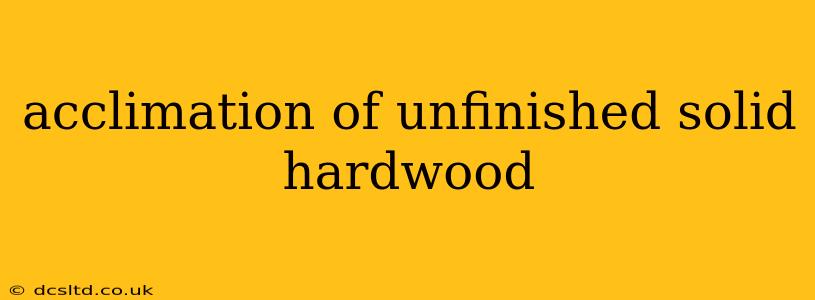Acclimating unfinished solid hardwood flooring is a crucial step before installation. Failure to properly acclimate can lead to significant problems down the line, including cupping, crowning, shrinking, and gaps appearing between boards. This comprehensive guide will walk you through the process, answering common questions and ensuring your hardwood flooring installation is a success.
What is Acclimation?
Acclimation is the process of allowing unfinished solid hardwood to adjust to the temperature and humidity levels of its intended environment. Wood is a hygroscopic material, meaning it absorbs and releases moisture based on the surrounding air. If you install wood that hasn't acclimated, the changing humidity levels in your home can cause the wood to expand or contract, leading to damage.
How Long Does Acclimation Take?
The acclimation period typically lasts 7-10 days, but this can vary depending on several factors, including:
- Species of wood: Different wood species react differently to humidity changes. Some are more stable than others.
- Thickness of the wood: Thicker boards will take longer to acclimate than thinner boards.
- Climate: Hot, dry climates might require a longer acclimation period than more humid climates.
- Packaging: The way the wood is packaged can affect how quickly it acclimates.
It's crucial to check the manufacturer's recommendations for specific acclimation times. Always prioritize the manufacturer's instructions over general guidelines.
Where Should I Acclimate My Hardwood?
The ideal location for acclimation is the room where the flooring will be installed. This ensures the wood adjusts to the precise temperature and humidity of that specific area. However, if that's not feasible, choose a location that's:
- Inside the house: Avoid acclimating wood in a garage or other unheated spaces, as temperature fluctuations can be extreme.
- Similar temperature and humidity: The closer the environment matches the intended installation area, the better.
- Away from direct sunlight and heating/cooling vents: Extreme temperature changes can disrupt the acclimation process.
- Free from drafts: Drafts can cause uneven drying or moisture absorption.
The wood should be stacked horizontally, keeping good airflow between boards.
What Happens if I Don't Acclimate My Hardwood?
Failing to acclimate your unfinished solid hardwood can lead to several issues:
- Cupping: The edges of the boards curl upwards.
- Crowning: The center of the board bows upwards.
- Gaps: Spaces appear between the boards as the wood shrinks.
- Buckling: The boards warp and become uneven.
These problems can be costly to rectify and may even require replacing the entire flooring.
How Can I Monitor the Acclimation Process?
Regularly monitor the humidity and temperature in the acclimation area using a hygrometer and thermometer. Keep a close eye on the wood itself, checking for any signs of warping or distortion.
Can I Speed Up the Acclimation Process?
No, attempting to speed up the acclimation process is generally not recommended. Using artificial methods can disrupt the natural moisture balance in the wood, potentially leading to more significant problems. Patience is key during acclimation.
What About Unfinished Engineered Hardwood?
While the principles are similar, engineered hardwood generally requires less acclimation time than solid hardwood because of its construction. Check the manufacturer's instructions for specific guidance. However, even engineered hardwood benefits from acclimating to the environment.
Should I Use a Moisture Meter During Acclimation?
While not strictly necessary, using a moisture meter can provide valuable information about the moisture content of the wood and help ensure it's adequately acclimated before installation. Again, refer to the manufacturer’s recommendations for target moisture content.
By carefully following these guidelines, you can ensure your unfinished solid hardwood is properly acclimated, setting the stage for a successful and long-lasting flooring installation. Remember, proper acclimation is an investment in the longevity and beauty of your hardwood floors.
